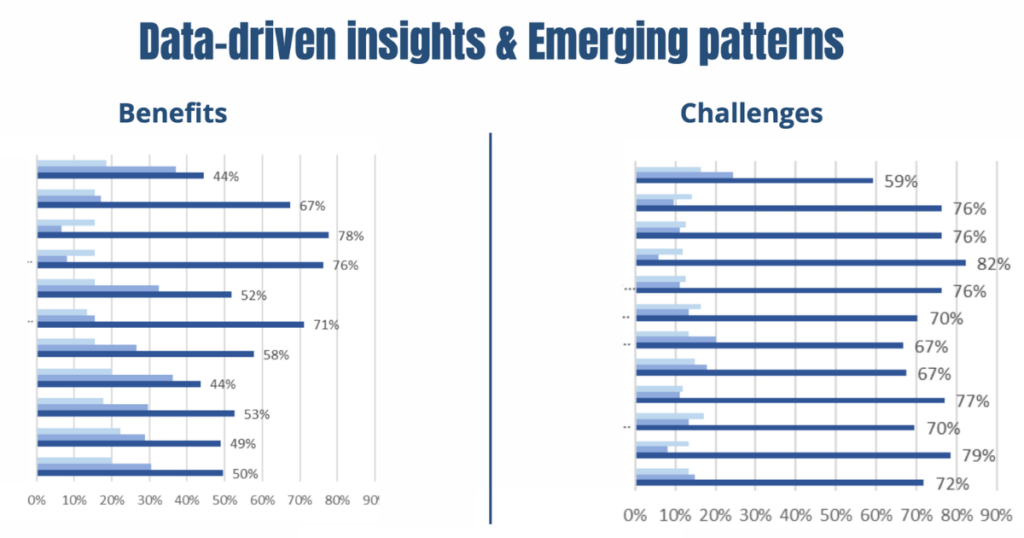
As artificial intelligence (AI) continues reshaping classrooms around the world, its role in English Language Teaching (ELT) is becoming more relevant—and more debated. From automating feedback to personalizing instruction, AI tools offer promising benefits. But they also raise new challenges: accuracy, ethics, teacher training, and student misuse.
My recent MA thesis set out to explore this evolving landscape from two angles: (1) a systematic literature review (SLR) examining global trends, and (2) a cross-sectional survey of 178 Moroccan ELT teachers to see how those trends play out locally.
This article shares the key findings, but also raises a bigger question: In the push to integrate AI into ELT, are we investing enough in the people behind the pedagogy?
Why This Research Matters
Globally, millions of teachers are experimenting with AI tools like ChatGPT, Magicschool, Quillbot, and Grammarly. But most studies I managed to access on the selected databases focus on higher education settings in Asia, leaving important gaps. What about primary or secondary schools? What about regions like South America, North Africa, or the Arab world?
In Morocco, English is a growing priority, but infrastructure and teacher training often lag behind. This research is one of very few in the country to systematically examine how ELT teachers are actually using AI, what tools they prefer, and what barriers they face.
How the Study Was Conducted
The research used a sequential exploratory mixed-methods design, and I want to take you briefly through each step.
- Phase 1: This began with a systematic literature review of 14 articles I was able to access from three well-known databases—Scopus, ScienceDirect, and Web of Science—published between 2014 and 2024. The process involved sifting through a much larger set of potentially relevant studies, many of which unfortunately had to be excluded because they were behind paywalls. The final selection captured a diverse range of contexts and approaches, offering a broad yet detailed picture of how AI has been integrated into ELT globally over the past decade.
- Phase 2: Building on the global findings, I designed a national survey distributed as an online questionnaire. To reach a wide cross-section of professionals, I shared it through established online communities and networks that bring together ELT teachers from different regions, teaching levels, and types of institutions in Morocco. This allowed the survey to capture voices from urban and rural contexts, from novice teachers to seasoned educators, reflecting a truly varied landscape of AI use.
Both phases focused on four core areas:
- AI tools being used
- How teachers integrate AI into classroom practices
- Perceived benefits
- Perceived challenges
Global Patterns: How AI Is Being Used in ELT
The systematic literature review of the 14 accessible studies revealed that ChatGPT emerged as the most used tool mainly for lesson planning, writing assistance, and classroom interaction. Other common tools included:
- Grammarly: grammar correction and clarity suggestions
- Quillbot: paraphrasing support
- Essay grading tools: automated writing feedback
- Chatbots & speech tools: for speaking and listening practice
- Image generators (like DALL·E): for vocabulary and visual learning
Interestingly, although global discourse now includes tools like Claude, Gemini, and even AI agents, most classroom research still revolves around ChatGPT and basic assistants. AI was most often used for writing and assessment tasks. Teachers found that automation saved time and improved consistency.
Perceived Benefits of AI in ELT
- Efficiency in planning and feedback: Many teachers found that AI could significantly reduce the time needed for lesson planning and marking assignments. AI tools streamlined the creation of exercises and provided rapid, consistent feedback, freeing up time for more interactive classroom activities.
- Personalization for learner needs: AI made it possible to quickly adapt materials for different proficiency levels or learning styles. Teachers could generate multiple versions of the same task, ensuring each student received appropriately challenging content.
- More engaging content through multimodal tools: By incorporating AI-generated images, audio, and even interactive exercises, teachers reported an increase in student motivation and participation. These tools helped break away from text-heavy resources and appealed to a broader range of learners.
- Support for teacher development and creativity: Teachers noted that experimenting with AI tools encouraged them to explore new pedagogical ideas. Many discovered innovative lesson formats or activities they might not have considered without AI’s input.
Perceived Challenges of AI in ELT
- Lack of training on AI integration: The absence of structured, formal training for teachers on how to integrate AI into language teaching emerged as one of the most pressing challenges. Many participants reported that their understanding of AI tools was self-taught, often through trial and error, leading to inconsistent and sometimes ineffective application.
- Over-reliance on automation: Some participants warned that depending too heavily on AI tools risks reducing both teacher and student engagement in critical thinking, creativity, and problem-solving. When lesson design, assessment, or even classroom interaction is outsourced entirely to automation, it can diminish the development of essential pedagogical skills for teachers and language skills for students.
- Plagiarism risks: Both the literature and Moroccan survey responses revealed that AI tools can make it easier for students to submit work that is not their own. Some teachers observed that learners copied AI-generated essays or assignments word for word instead of using their own language skills. In certain cases, the content was polished and grammatically sound, but it failed to reflect the student’s actual proficiency, making accurate assessment challenging.
- Infrastructure gaps: Respondents highlighted issues such as unreliable internet connections, outdated or insufficient devices, and a lack of technical support in schools. In rural areas especially, poor connectivity and limited access to hardware significantly restricted the potential benefits of AI integration.
- Inaccurate or biased AI output: Teachers in both global and Moroccan contexts reported that while AI tools sometimes provide information that is factually incorrect or culturally inappropriate. Such inaccuracies can mislead learners if not carefully checked, and biases embedded in training data may subtly influence the tone or content of materials

The Moroccan Experience: Curiosity Meets Caution
Before asking Moroccan teachers about how they use AI in ELT, I first asked them whether they used it at all. The majority confirmed having used AI at some point in their teaching process, but 24% of participants said they had never used AI in ELT. Curious about this, I explored their reasons: most of these teachers explained that they simply did not know how to use AI due to a lack of training, while some cited limited access to the necessary technology. Others expressed strong ethical concerns. Interestingly, a small group, though not the majority, said they deliberately chose not to adopt AI tools or join the trend.
The Moroccan survey revealed strong interest in AI tools overall:
- 76% of respondents reported using at least one AI tool
- Top tools: ChatGPT, Grammarly, Quillbot, Gemini, Microsoft Copilot
Teachers primarily used AI for lesson planning, generating classroom activities, providing formative feedback on writing, and creating differentiated materials. A smaller group experimented with AI for speaking and listening tasks.
When comparing Morocco with the global context, many trends align. Like their global fellows, Moroccan teachers primarily used AI for writing and assessment-related tasks, valued efficiency and creativity, and appreciated the ability to differentiate learning. In terms of challenges, Moroccan teachers reported many of the same issues seen globally: concerns about inaccurate or biased AI output, the risk of over-reliance on automation, plagiarism and academic dishonesty, uneven access to devices and reliable internet, and the absence of structured training on how to integrate AI pedagogically.
An Unexpected Pattern in the Moroccan Context

When comparing data and graphs representing the levels of agreement of Moroccan teachers with statements describing the benefits and challenges of AI integration in their teaching, a noticeable pattern was revealed. As you can see in the graph above, there is a general tendency of teachers to agree more with challenges than with benefits. At this point, I wondered whether this trend is real or merely due to chance and data variability. To get some insights, I ran an inferential statistical test called the Wilcoxon signed-rank test, which revealed that it is not just a coincidence but a statistically significant variability. This means policymakers should be aware that enthusiasm is tempered by legitimate concerns, and training programs need to address these challenges directly. In other words, Moroccan teachers seem to take a cautious more than enthusiastic stance when dealing with AI in teaching.
What This Means for Teachers and Policy Makers
For teachers
- Learn about AI. To make the most of AI’s potential, take time to understand how different tools work, their strengths, and their flaws. Knowing where AI excels and where it falls short will help you use it more wisely. If you’re using ChatGPT, as many teachers do, start by learning the basics of “prompting,” the way you phrase your requests. Even small improvements in prompt design can make a significant difference in the relevance and quality of the output you receive.
- Start small: Use AI to enhance, not replace, your work. Begin by integrating AI into just one or two aspects of your teaching, such as generating warm-up questions or drafting sample answers. This gradual approach lets you explore the benefits while keeping full control over lesson content and classroom interactions.
- Focus on pedagogy: Let teaching goals drive AI use. Always decide how and why to use AI based on what you want students to learn, rather than letting the tool’s capabilities dictate your lesson. This ensures AI supports your educational objectives instead of distracting from them.
- Share strategies and experiences with peers. Discussing your successes and challenges with colleagues can help you discover new uses for AI and avoid common pitfalls. Collective knowledge-building also strengthens the whole teaching community’s confidence in using these tools effectively.
For school leaders and policy makers
- Provide targeted training on integrating AI pedagogically and ethically. Training should go beyond showing teachers how to operate AI tools; it should focus on linking AI use to sound teaching practices and ethical standards. This ensures teachers can harness AI’s benefits without compromising learning quality or integrity.
- Invest in infrastructure: reliable internet, devices, and maintenance. Without stable connectivity, modern devices, and proper technical support, AI integration will remain inconsistent and frustrating. Infrastructure investment ensures all teachers and students can access and use AI tools effectively.
- Develop clear guidelines on ethical and effective AI use. Schools and education authorities should create policies that outline acceptable uses of AI, address data privacy, and prevent academic dishonesty. Clear guidance builds teacher confidence and promotes responsible, purposeful AI adoption.
Final Thoughts: Tools Are Not Enough
This research confirms that AI cannot replace teachers, but it can support them when introduced thoughtfully. Without investment in training, infrastructure, and ethical frameworks, the gap between potential and practice will remain.
AI in ELT is not just about adopting new tools; it’s about empowering teachers to use them well.
El Mostafa Hamadi, researcher in AI in English Language Teaching, ELT professional, and CELTA & IELTS mentor. Connect with me on www.linkedin.com/in/elmostafahamadi or elmostafahamadi@gmail.com
